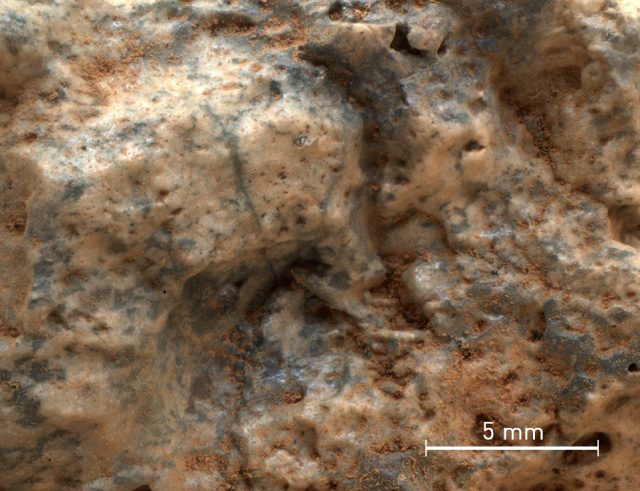
Old school geology can’t really be done by helicopter. It requires boots and hammers on the ground, interrogating rocks until they give up their identities and reveal their histories. Planetary geologists are pretty much trapped in helicopters, analyzing whatever can be measured by passing or orbiting spacecraft.
But there are some rare exceptions. What the Mars Curiosity rover lacks in hammers, it more than makes up for in lasers. With those armaments, Curiosity is uncovering some basics of Martian geology that can fill in portions of the history we’ve gleaned from orbit.
Mars’ crust is dominated by rocks produced through volcanism. It seemed to lack Earth’s igneous diversity, however, and little is known about Mars’ early volcanic history around 4 billion years ago. But that’s exactly how old the rocks of Gale Crater, where Curiosity spends its roving days, are.
One of the most basic divisions of igneous rocks is drawn along chemical lines. Dark-colored “mafic” rocks contain lots of magnesium- and iron- (Fe) bearing minerals (think basalt). Lighter-colored “felsic” rocks contain more of the minerals feldspar and quartz (SiO2)—think granite. Satellite imagery of Mars shows that its surface is largely mafic rock, but we've identified some limited patches of light-colored rock that seemed to contain feldspar and quartz. Remember, however, that helicopter geology is hard. The presence of felsic rocks was not without some ambiguity.
A large team of researchers led by Violaine Sautter of the National Museum of Natural History in Paris has published a new study based on some light-colored rocks that Curiosity was able to analyze. Curiosity’s ChemCam laser blasts away a tiny bit of a rock’s surface and detects the elements that are present. Curiosity also carries cameras that replace another geologist’s companion, the magnifying hand lens, that help the researchers back on Earth identify these Martian rocks.
The new study looks at twenty-two light-colored, igneous rocks Curiosity inspected, half of which got the laser treatment. The rocks fell into three groups. Some were made up of large crystals, indicating that they cooled slowly, below ground. Some were made up of microscopic crystals and were riddled with bubbles, indicating that they erupted from a volcano. And the third group was a sort of hybrid, with large crystals of one mineral surrounded by tiny crystals of others—often the product of a magma that cools slowly for a while before erupting.
Looking at their chemistry, that hybrid rock turned out to be just a little more felsic than Mars’ typical basalt. The other two were quite a bit more felsic. The group made of large, visible crystals had about the recipe of a white-with-black-specks flavor of granite that rock taxonomists know as “granodiorite”.
The specific chemical varieties include things not found on Mars before. But apart from rounding out Mars’ rock collection, they have some pretty interesting things to tell us about Mars’ early history. The granite-like rocks are similar to some of the rocks that make up Earth’s earliest truly continental crust, which differs from the basalt that makes up the seafloor. That could have come about by partly melting pre-existing basalts that began to sink back into Mars’ still-soft interior, for example.
Regardless of how it happened, the idea that there was continental crust being manufactured on Mars makes that planet’s early history look more like the Earth’s than we thought. The researchers also note that the existence of some of these rocks “challenge[s] the simple idea of continuous cooling of the Martian mantle over geologic time, pointing to more complex global or local variation in mantle temperature”.
That’s particularly true if the felsic-looking rocks that have been spotted by satellites tell us that there was lots of igneous activity like this going on around four billion years ago. That could even help explain why efforts to measure Mars’ density have come up a little light in the southern hemisphere—there could be a fair amount of continental crust mixed in with all that Martian basalt.
Nature Geoscience, 2015. DOI: 10.1038/NGEO2474 (About DOIs).
reader comments
19